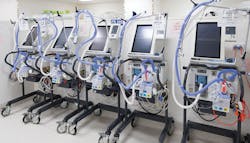Incorporate pandemic concerns in supply chain, construction and renovation projects
The COVID-19 pandemic has been a jolt to the healthcare supply chain. There is struggle and disruption from manufacturing through distribution and onto the customer.
It’s not hard to see how this happened. For the last 10+ years healthcare supply chains have purposely become more efficient and streamlined. Our mutual goal has been to reduce costs and save money along the supply chain. Less inventory, less storage and just-in-time product delivery has been the supply chain mantra. We as an industry have been very successful. Most players along the chain did maintain an emergency inventory, but not enough for this level of pandemic.
What about the equipment side of the pandemic, including products needed to outfit temporary ERs, triage areas, ICU patient rooms, and laboratories that were needed to test and treat COVID-19 patients? Although most of the news focused on PPE and ventilators, there have been significant shortages of thermometers, vital signs monitors, beds, cots, stretchers, wheelchairs, IV poles and isolation carts to name a few. As the crisis curve flattens in many areas of the country here are some thoughts about possible next steps and future plans.
How are you dealing with equipment during and after the pandemic, and keeping it ready for the next one?
During the crisis many healthcare systems have purchased excess equipment that will no longer be needed. They have no place to store it and not enough resources to disassemble, tag and identify it as pandemic inventory so that it is ready the next time a pandemic strikes. Some newly acquired equipment may be used to replace older equipment already in use in the healthcare system. There are equipment-focused distributors who do have storage, logistics and biomed solutions, as well as third-party logistics companies (3PLs) and other local storage facilities. Each system needs to figure out what they need and who can best address their issues, including disassembly, pick-up, storage, inventory control, preventive maintenance checks and redelivery when needed again.
How do you keep your equipment supply chain resilient for the next pandemic?
Many healthcare systems have developed long standing relationships with favored equipment manufacturers, and most have a primary or exclusive national distributor partner. Because of manufacturer allocations, many manufacturers and distributors have not been able to meet their customer needs during this recent crisis. Healthcare supply chains will need to build in some flexibility going forward by developing relationships with secondary manufacturers and distributors. Look for local and equipment-focused distributors who can be called upon for specific expertise and assistance in desperate times.
How will you create better emergency preparedness in your next new construction project?
Many newer construction projects have focused on green initiatives, aesthetics and improving patient satisfaction, which are all important. Emergency preparedness guidelines also will need to be added to future new construction projects. Here are some things to consider:
- Designate areas that can be used to increase ICU beds and overall capacity, such as lobbies, cafeterias and non-acute patient rooms
- Outfit these areas with appropriate power, gas and connectivity outlets, etc.
- Design rooms for flexible uses with rail or other systems so that any patient room can be converted to an ICU room on demand
- Plan patient rooms for the best possible infection control flow, keeping caregiver and patient safety at the forefront
- When outfitting new facilities, look for equipment that can help with advanced disinfection and infection control, such as copper infused IV poles and stretchers, anti-microbial surfaces, UV light sterilizers and sanitizers, or anything that can keep the spread of a hospital-associated infection (HAI) to a minimum
- Historically hospitals have been quick to discard their old equipment when outfitting new facilities. Perhaps consider repurposing that equipment to be backup inventory for disaster preparedness
There obviously will be a lot of discussion within healthcare supply chains in the next few months that include assessing recent pandemic responses, what was done right and what could have been done better. New emergency preparedness plans will be devised and emergency equipment lists will be created. As this happens keep these observations in mind. With thoughtful preparation and worst-case preparedness, all of us in the supply chain will do better next time.
About the Author
Cindy Juhas
Chief Strategy Officer
Cindy Juhas is Chief Strategy Officer for CME Corp (CME), a national full-service healthcare equipment distributor, whose mission is to help customers reduce the cost of the new equipment they purchase, and make their equipment specification, delivery, installation, maintenance and disposal processes more efficient. CME offers a full array of logistical, biomedical and technical services to serve their healthcare partners. She can be reached at [email protected].
